This is the fifth piece in a blog series written by Craig Anderson as he documents the design and construction of an off-grid LEED Gold passively-heated home. See post 1 of the off-grid homes blog here, the overview . or post 2 in the off-grid homes blog here covering design and construction choices. or here see post 3 in the off grid homes blog about off grid power generation and here see post 4 all about off-grid heating systems
In years past, the mechanical systems and appliances within off-grid homes looked quite different from typical grid-tied homes. Electricity generation was extremely difficult and expensive at the home scale, so there was much less electrification. Instead, off-gridders used other technologies like wood stoves, kerosene lamps, and propane powered appliances.
One can still find most of these electricity-light home systems, including such things propane lighting and propane powered refrigerators. However, these systems are made at such a small scale and are in such small demand, that they are quite expensive and do not perform incredibly well. Thankfully, an off-grid house today can maintain essentially all the comforts of on-grid living, as long as one is careful about making choices.
Two trends have allowed this to happen. First, equipment for solar power generation and storage is quickly falling in price, and it is now possible to have a regular supply of electricity at a home for a manageable cost.
The second trend is large increases in efficiency of all of the electronics used in our homes. The normal, high-efficiency, often ENERGY STAR approved appliances and other electronics of today use just a fraction of the power of their predecessors.
Put all of these trends together, and it is now possible to use all off-the-shelf products from standard stores, as long as the most efficient of available options are chosen. The one thing that is difficult to do with electricity in an off-grid home is heating. Whether it be home heating, water heating, the kitchen range, clothes dryer, all of these are energy hogs and are not affordable in today's off-grid home.
In our case, we use propane to do most of this heavy lifting (though I hope to eliminate the propane at some point in the future). Below is a run-down of all of the systems that we have put into our home.
Range
We have a propane range, one of the basic models that was available at the local Sears (the Kenmore 5.0 cu. ft. Freestanding Gas Range w/ Variable Self-Clean, Model #74132). This unit has 5 burners on top, and propane burners at both the bottom and top of the oven. This unit does require some electricity for full functionality. The range has electronic sparkers to light the burners, though these can be lit with a match or lighter if there is no power.
The oven, however, requires a larger and more constant supply of power, as a heating element stays on at all times when the oven is heating. I have not been able to find the exact power draw for the stove heating element, but I think that it is around 200 or 300 watts. It would have saved a bit of electricity if there were a pilot light or a sparker inside the oven, but these models are harder to find.
Refrigerator
A refrigerator is one of those modern conveniences that would be very difficult to live without. And with refrigerated and frozen foods, it isn't possible to turn off the power when you are away, unless you empty out the whole thing.
As I mentioned above, one can run a refrigerator on propane, but these units leave something to be desired when compared against a typical fridge. Thankfully we produce enough electricity to keep a fridge powered. We have a Kenmore 596.6938, a 20 cubic foot model that is rated to consume 459 kWh/year. There are a few fridges that have power consumption as low as 350 kWh/year (less than 1 kWh/day), but they were a bit small for a family that does some entertaining.
Dishwasher
We wouldn't have needed a dishwasher necessarily, but it is a nice convenience. We picked up an ENERGY STAR rated Kenmore model 630, which EnerGuide lists as a 269 kWh/year expected power usage. We generally only run it when it's full, and it requires approximately 1 kWh per load of dishes washed when run on 'eco' mode.
Clothes washer
We chose a high efficiency front-loading washer, again by Kenmore. This is one of the more efficient models available. Front loading washers tend to outperform top loading models, and provide one additional benefit - an extra powerful spin cycle. By spinning at several thousand RPMs, the vast majority of the water is pulled out of the clothes before one even takes them out of the washer. This allows a very quick air drying, hung either outside on a line, or in the house on racks. We decided that it would not be worthwhile to try to add a dryer. Electric units consume too much electricity, gas dryers are more expensive, and we already were getting most of the drying done by the high-speed spin cycle.
Air handling
In any tightly built house, one needs to provide for ventilation. In older and draftier homes, a lot of air leaks into and out of a house just through little cracks around joints, windows, and doors, but with new high-efficiency construction there is a strong risk of the air getting stale. Our home ended up very tight (see past post here), so we needed mechanical ventilation.
This is accomplished by a heat recovery ventilator (HRV), which serves two purposes. First, the HRV circulates stale air out of the house while bringing fresh air in. All sorts of gases can build up inside homes, from cooking, off-gassing from materials, even simple human habitation, and these are vented to the outside when bringing in fresh air. Second, an HRV exchanges heat from the venting air with incoming air in a heat exchanger.
This allows the home to hold onto more heat in the winter, and keep out some of the heat in the summer. We settled on the LifeBreath 155 Max, which sized nicely to our air circulation needs, while consuming only 40 watts, less than 1 kWh/day, on the low setting.
Lighting
Just in the last 3-4 years, there has been a sea change in lighting, as LED technologies have become cost-competitive with the compact fluorescents and incandescents that came before. While still somewhat more expensive than these other choices, LEDs last much longer (often estimated around 20 years), and consume only a fraction of the energy. We put in all LED lighting to minimize electricity use. Some of it is in specialized fixtures, but most of it is screw in or pin type bulbs, and this was only a bit more expensive than other options available. When lighting up the house at night, the total lighting loads seldom exceed 100 watts.
Water heating
We use propane to do our domestic hot water heating, with an indirect water heater powered by our propane boiler (see post about our heating system here). Our boiler has a set of heating loops that come off of it, and one of those loops goes inside the water tank. A heat exchanger consisting of a set of copper coils containing the heated glycol pass heat to the domestic water in the tank. Because this setup uses a relatively powerful boiler when heating the water, it is actually able to provide continuous hot water for such things as bathing. The water heater is set up to take precedence over space heating, so there is always a good supply of hot water.
Phone and internet system
While it was appealing to have no phone or internet at our home in the woods, it wasn't practical. Both my wife's and my work depend on being internet connected, and it can often be important to be able to make phone calls. However, since we are so far off the beaten path, we have no phone lines, and only a very weak cellular signal at our home. To remedy this situation, it took a few different steps. The good news was that the phone and internet systems combined require less than 10 watts to keep a constant and high quality connection.
To improve the cell phone reception, I set up a cellular signal booster which consists of several parts. First, there is an antenna mounted to the outside of the house which is pointed at the nearest cell tower about 5 miles away. From this antenna, a coaxial cable is run into the home into a cell signal amplifier, which is a box about the size of a typical modem. This is then connected to an interior antenna. When one uses a cell phone, the signal is received by the interior antenna, passing through the amplifier and exterior antenna to communicate with the cell tower. This system actually works very well, bringing the signal from one that is so weak that calls often cannot connect, up to a very strong signal (5 out of 5 bars of reception listed on the phone).
To have a ready internet connection, we connected a cellular modem. This works just like any other modem, but instead of connecting through telephone or cable wires, it communicates over the cellular network just like a smartphone. Our local phone provider has a 'family plan' for data sharing, which we now share between smart phones for myself and my wife, as well as with the wifi network created by the cellular modem. Data is more expensive this way than through a wired connection, but as long as we don't use the network for high bandwidth activities such as video streaming, it works very well.
Now you know more about building and living in an off-grid home and how it can help showcase reducing the carbon footprint of eco homes & sustainable construction...Find more pages about sustainable and resilient green building techniques here :
Find more about green home construction in the Ecohome Green Building Guide pages - Also, learn more about the benefits of a free Ecohome Network Membership here. |


























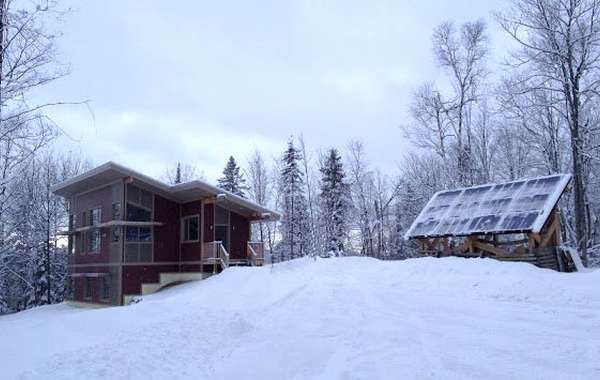
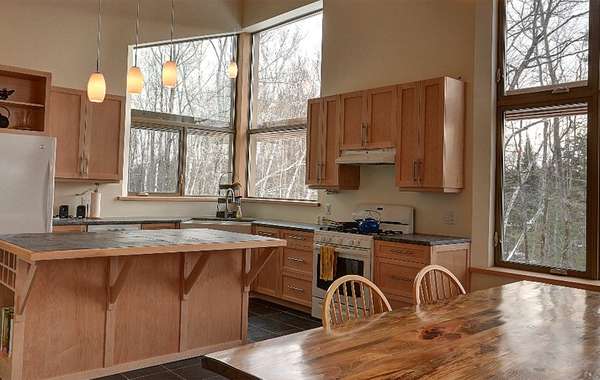

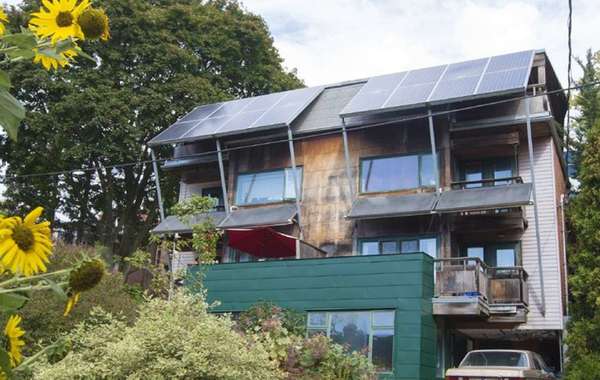


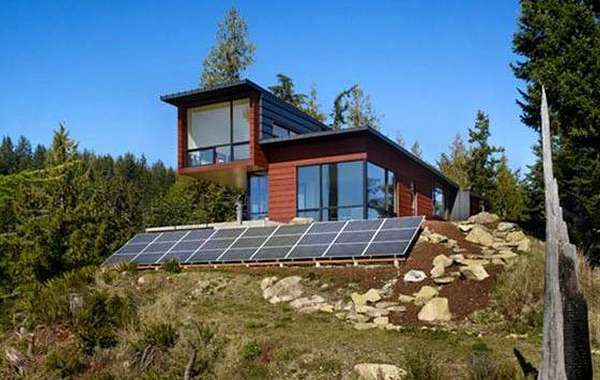

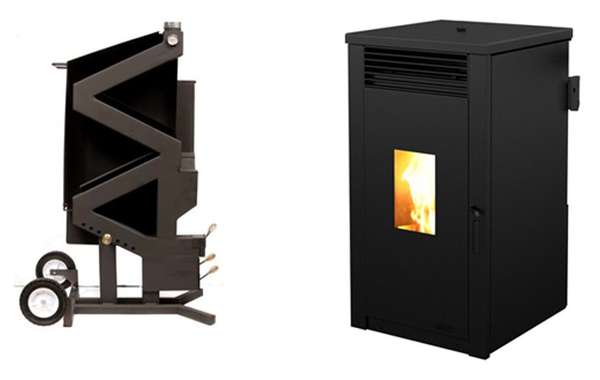
my thoughts on the off grid is co-gen and small solar array... frees power all year just pay for heat value
thanks, im not looking for a system .im doing this my own way ..read less than 20 g
Thank You for the reply
We have had an off grid house as a cottage for years and have just sold our main residence and moved to the cottage/house. We are experiencing a large learning curve living in the winter and would so appreciate help. We have two masonary stoves thus our house is not one floor but four floor tall centred around the kacheloffen (or masonnary stove). The stoves do not heat certain rooms in the house completely so I am interested in the direct vent option for certain rooms. Thank you for that article. Would love some help. For instance - I have a Jenn Air propane stove but the oven fan uses so much electyricity that I've stopped using the oven on cloudy days (I live int NOva Scotia. Some winters are cloudy, some sunny). Our extra heating are bathrooms using on demand propane and infloor and in floor in the basement which also has a gas jotul stove for quick heating. However I'm concerned about how much electricty the Navien on demand propane hot water heater uses to turn on and off. Something we were not told about and then when I researched I found varing opinions (perhaps it is not that much - but opinions differ). I would love to know more about appliances - and if the Kenmore range you use, uses much electricty. I would love a 5 burner stove. I am a cook. I cook a lot often with five burners. I'm hoping we can keep off-grid. We are nestled away and in Canada they require 40 ft of trees to be cut for poles. This webside is the best I have found. most people have tiny houses. We have a full time house and also are planning a garage - so we want to do things the most efficient and keep off grid if possible.
Thank you in advance!!
Mary